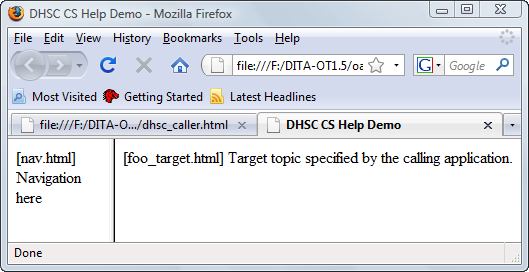This topic explains how to configure your browser-based Help system to respond to
context-sensitive Help requests from a software application.
Overview
If you are deploying a browser-based Help system in conjunction with a software
application, you can configure your main HTML Help file to display a specific target Help
file when so requested by a calling software application.
Note: The following JavaScript functions do not depend technically on anything inside your
DITA source files or anything generated by the DITA Open Toolkit. They are generic functions
that support generic HTML.
Single-pane Browser Help Systems
In some situations, you may not need to deploy a fancy, multiframe HTML Help solution to
support a software application. In these situations, you can add a few lines of JavaScript
to the beginning of your main Help file to process incoming hyperlink calls that target a
particular HTML Help file.
For example, if my software application needed to display a particular Help screen (targetHelpTopic.html), I could build a hyperlink that would call the main Help
file (1file.html) and ask it to display my target Help topic.
Here's the HTML hyperlink call.
<a href="1file.html?targetHelpTopic.html">link</a>
Here's the JavaScript to put at in your main Help file.
<HTML>
<!-- One-pane Browser Help System 1file.html -->
<body>
<script language="javascript">
targetTopic = window.location.search.substring(1);
window.location.href=targetTopic
</script>
</body>
</html>
When the main Help file (1file.html) receives the HTML hyperlink call <a href="1file.html?targetHelpTopic.html">link</a>, it identifies any
text that follows the question mark (?) as one or more arguments being passed to it. In this
example, the script identifies targetHelpTopic.html as that argument and
makes that HTML file name the current topic to be displayed in the browser.
Note: This setup works well for captive or embedded Help systems with restrictive or highly
predictable calling procedures. If a user or an application calls the main Help file without
specifying a target topic, the main Help file will generate an Error 404 "File not found".
Multiframe Browser Help Systems
Many browser-based Help systems use multiple frames to provide the customer with topic
navigation, search, indexing, and other basic amenities. To get a multiframe Help system to
respond to the same context-sensitive hyperlink call is a bit more complicated because of
some restrictions in how HTML frames and JavaScript interact.
Here are the elements of our little example.
Figure 1. JavaScript Elements
| Elements |
Description |
|
Software application
|
Any software application that can generate HTTP calls to a browser will work. For
the sake of simplicity, I use an HTML document that contains one hypertext link.
<html>
<a href="dhsc_help.html?target.html" target=_blank>
Call the help system file and pass it an argument
(the name of the target help topic).</a>
</html>
|
|
Hyperlink
|
The software application passes two arguments to the Help browser:
- Main HTML Help file name (dhsc_help.html)
- Target Help file name to be displayed
(target.html) in the main Help window.
Preserving the question mark (?) between the name of the main Help file name and
the target Help topic file name is critical. Your browser uses this question mark to
delimit the name of the target Help topic (target.html) from the name
of the main Help file (dhsc_help.html).
|
|
Main Help file
|
The main Help file here contains little more than a call to a JavaScript library
file that performs all the real work.
<!DOCTYPE html PUBLIC "-//W3C//DTD XHTML 1.0 Frameset//EN"
"http://www.w3.org/TR/xhtml1/DTD/xhtml1-frameset.dtd">
<html xmlns="http://www.w3.org/1999/xhtml">
<head>
<title>DHSC CS Help Demo</title>
<!--Insert cshelp.js library -->
<script language="Javascript" src="cshelp.js">/script>
<meta http-equiv="Content-Type" content="text/html; charset=iso-8859-1">
</head>
<script language="javascript">
insertFrameset()
</script>
</html>
|
|
cshelp.js
|
The cshelp.js library contains only one JavaScript function named
insertFrameset.
function insertFrameset ()
{
defaultTopic = "default.html";
targetTopic = window.location.search.substring(1);
if (targetTopic=="")
{
target_contentsframe=defaultTopic
}
else
{
target_contentsframe=targetTopic
}
document.write('<FRAMESET cols="20%, 80%">');
document.write('<FRAME src="nav.html" name="navframe">');
document.write('<FRAME src="'+target_contentsframe+'" name="contentframe">');
document.write('</FRAMESET>');
}
The variable targetTopic points to the name of the target topic (target.html) embedded in the hyperlink call. If the JavaScript function
receives no argument from the hyperlink that calls it, it uses the name of the HTML
topic declared as defaultTopic. The final lines of the script build the
frameset calls that specify frame dimensions and contents (HTML files).
|
Figure 2. Sample Context Sensitive
Help
Summary
These JavaScript functions support small-to-medium Help systems in any language because
they place the entire burden of constructing and managing context-sensitive hypertext links
on the calling application. With larger Help systems or with distributed Help systems, this
overloading becomes risky or impossible.
Stan Doherty
Individual
OASIS DITA Technical Committee
OASIS DITA Help Subcommittee
